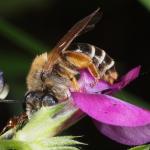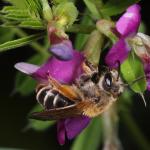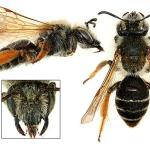The largest of the four British species in the Andrena wilkella group. Guichard (1971) provides characters distinguishing both sexes of A. lathyri from those of its three relatives, but he was aware at that time that the best character for separating the females is the deeply enmarginate pygidium, a character unique amongst British Andrena
A very rare mining bee, having been recorded from only two sites. K M Guichard and S Thewes collected four males and a female along a grassy bank beside an abandoned railway track bed near Burbage, Wiltshire, on 16th May 1970 (Guichard 1971). Many further specimens of both sexes were also collected by Guichard on 19th May 1970 and 15th May 1971. An abraded female was finally collected by him there on 4th July 1971. A subsequent search by him of the collections in The Natural History Museum, London, produced an unidentified (or misidentified) female A. lathyri, collected at Moorlinch, Somerset, on 22nd May 1950, by J Cowley. Though common at Burbage in 1970-71, since that time, despite many visits to the site by several hymenopterists, the species has remained exceedingly elusive, with only a single female being encountered on 10th May 1990 by S P M Roberts, suggesting that the bee may still be established in the area. Unfortunately, the site is now becoming unattractive to bees generally, owing to the development of dense scrub, which is shading out nectar and pollen sources. The range extends from southern Fennoscandia to Switzerland, Austria and Turkey. It has also been reported from Ukraine and Moldova.
This species is listed as Endangered (RDBI) in both Shirt (1987) and Falk (1991).
Open grassland supporting vetches.
Univoltine, about mid-May to June; exceptionally early July.
No nests have been found in Britain. In Europe, the species apparently nests solitarily in loamy soil, often along woodland rides and at the edge of broad-leaved woodland (Kocourek 1966; Dylewska 1987; Westrich 1989).
In Wiltshire, it was seen visiting bush vetch and common vetch (Vicia sativa) (Guichard 1971). Probable nectar sources in Germany are bugle (Ajuga reptans), dandelion (Tataxacum officinale) and willows (Salix spp.)(Stöckhert 1933).
None known in Britain.
2002




